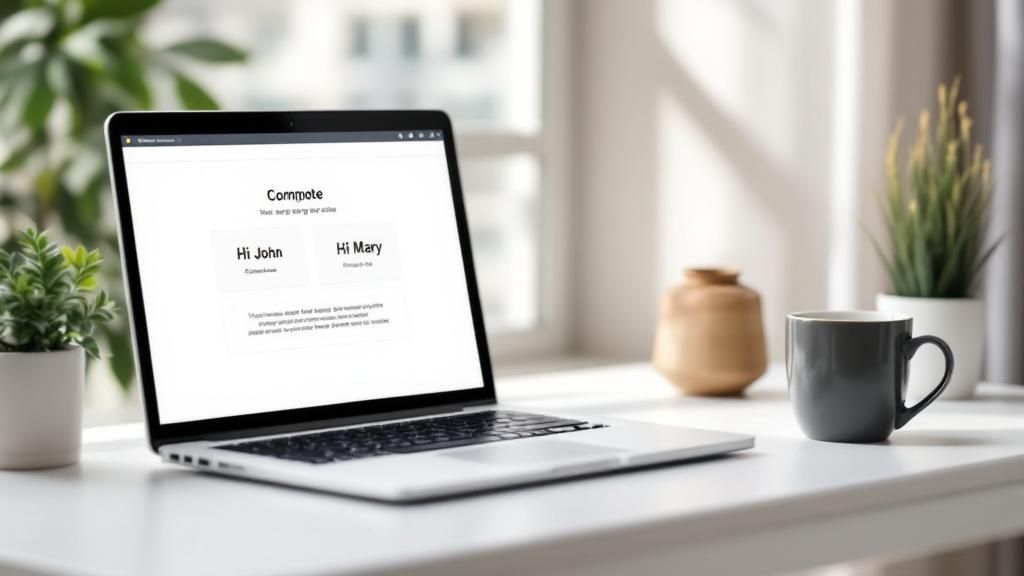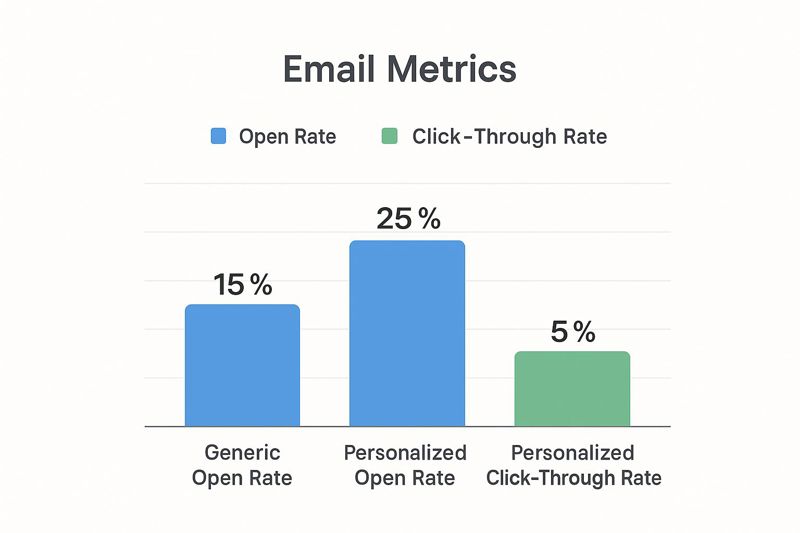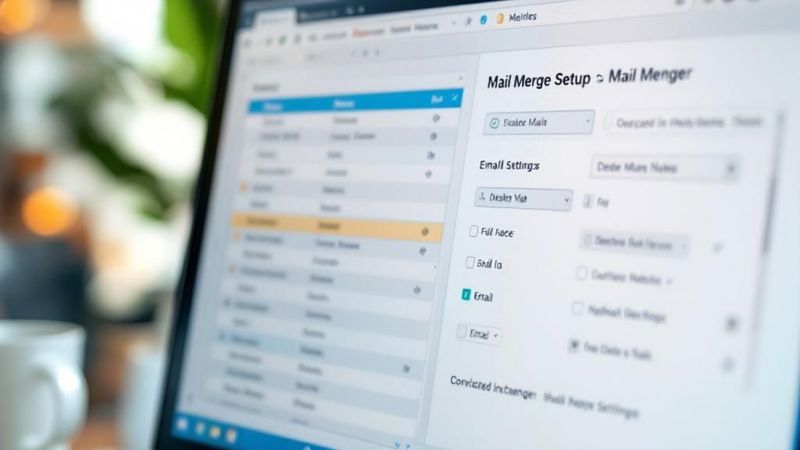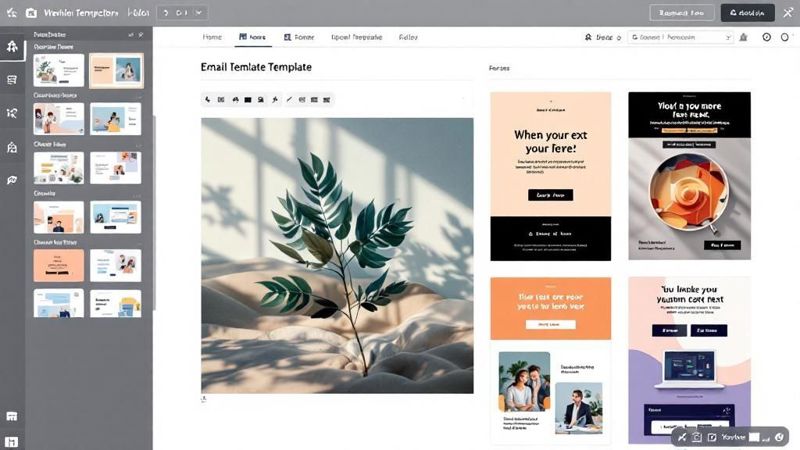If you want to send a mass email that feels like a one-on-one conversation, you'll need an email marketing platform. These tools are built with features like merge tags or dynamic content that make personalization easy.
Forget about hitting "Bcc" in Gmail. That's a limited and pretty unprofessional approach. The right tools let you insert unique details—like a first name, company, or last purchase—into a single email template. The platform then works its magic, creating a personalized copy for every single person on your list automatically.
Why Personalized Mass Email Beats Generic Blasts

Sending a generic blast to your entire list might feel efficient, but it's a strategy that often backfires. We all live in an era of overflowing inboxes, and impersonal messages are the first to get ignored, deleted, or even worse, flagged as spam. The smart approach is to make every mass email feel like it was sent individually, creating a real connection at scale.
This isn't just about dodging the spam filter; it's about building genuine relationships. A generic email shouts, "You are just one of many." A personalized one whispers, "I see you, and this message is for you."
The Power of an Individual Connection
Imagine you get an email with the subject line, "A Special Offer for Our Customers." You'd probably dismiss it as just another promo, right?
Now, what if you got one that said, "John, a follow-up on your interest in our marketing automation tools." That second version feels immediately relevant and is far more likely to get opened. That's the difference.
When you send emails that feel individual, you’re using data to create relevance. This can be as simple as adding a first name or as sophisticated as tailoring content based on past purchases or website activity. Every personalized touchpoint reinforces that you actually understand what your recipient needs.
The core idea here is simple: people buy from those they know, like, and trust. Personalization is the digital equivalent of a firm handshake and remembering someone's name—it's the foundation of that trust.
Driving Real Engagement and Conversions
The data tells a clear story: this targeted approach just works better. With over 392 billion emails sent every single day worldwide, standing out is non-negotiable.
Personalized emails have been shown to generate six times higher conversion rates than generic messages. On top of that, segmented campaigns can boost revenue by a staggering 760%. The numbers don't lie.
Making your messages feel personal goes beyond just text, too. To truly make your emails resonate, think about the impact of personalized video email marketing. This can elevate your outreach and create a memorable experience that a simple text campaign just can't match.
Ultimately, learning how to send a mass email individually isn't just a technical skill—it's a strategic shift. It drives higher engagement, builds stronger customer loyalty, and delivers a measurable return on your marketing efforts.
Choosing Your Toolkit for Individualized Emails
If you're serious about sending mass emails that actually feel personal, your everyday Gmail or Outlook account just won't cut it. They simply aren't built for the job. Trying to send in bulk from a standard inbox is a fast track to deliverability problems, zero personalization, and a damaged professional reputation.
To do this right, you need a dedicated platform. These tools are the engines that power effective, personalized email outreach, handling all the heavy lifting of list management, personalization, and analytics so you can focus on your message.
Email Service Providers vs. CRM Platforms
So, where do you start? Your choice generally boils down to two main types of tools: Email Service Providers (ESPs) and Customer Relationship Management (CRMs).
An Email Service Provider (ESP) is a tool built from the ground up for one thing: sending email campaigns. Think of platforms like Mailchimp or ConvertKit. They are masters of creating, sending, and tracking emails. If your main goal is sending out a great newsletter or managing subscriber lists, an ESP is often the most direct and affordable route.
On the other hand, a Customer Relationship Management (CRM) platform, like HubSpot, is a much bigger beast. Yes, it has powerful email marketing features, but its real purpose is to manage the entire customer journey. A CRM connects the dots between your email campaigns, sales calls, website visits, and support tickets, giving you a 360-degree view of every single contact.
Choosing the right tool isn't just a technical decision; it's a strategic one. Your choice should align with your business goals, whether that's simple audience communication or complex, multi-channel customer relationship management.
The difference in results is impossible to ignore. Just look at the performance gap between generic and personalized emails.

The data speaks for itself—personalization is key to getting people to actually open, read, and click on your emails.
To help you decide which path is right for you, here’s a quick breakdown of the different tool categories available.
Comparison of Email Sending Tools
| Tool Category | Key Personalization Features | Best For | Typical Pricing Model |
|---|---|---|---|
| Email Service Provider (ESP) | Merge tags, basic segmentation, automation workflows, A/B testing. | Newsletters, content creators, small businesses focused purely on email marketing. | Tiered plans based on subscriber count or email volume. |
| CRM with Email Marketing | All ESP features plus lead scoring, deal tracking, and full customer activity history. | Sales-driven businesses, B2B companies, marketing teams needing a unified customer view. | Per-user/seat pricing, often with tiered feature sets and contact limits. |
| Sales Engagement Platform | Advanced sequencing, email tracking (opens, clicks, replies), call integration. | Sales teams, B2B outreach, account-based marketing (ABM) campaigns. | Per-user, per-month subscription. Often higher cost than ESPs. |
Ultimately, the best tool is the one that fits your specific strategy and budget. Don't pay for a full CRM if all you need is a solid ESP.
Key Features to Look For
No matter which platform you land on, there are a few non-negotiable features you'll need to send personalized emails at scale. These are the capabilities that separate the pros from the amateurs.
- Merge Tags and Personalization Fields: This is personalization 101. It’s the magic that lets you insert contact-specific data like
{{FirstName}}or{{CompanyName}}directly into your email copy, instantly making it feel more individual. - Audience Segmentation: This is absolutely critical. Segmentation allows you to slice your main list into smaller, more targeted groups based on things like their location, purchase history, or how often they open your emails. Sending the right message to the right segment is a game-changer.
- Dynamic Content Blocks: A more advanced feature, but incredibly powerful. Dynamic content lets you show different content blocks to different segments within the same email. For instance, a retailer could send one campaign that automatically shows menswear to male subscribers and womenswear to female subscribers.
- Automation and Workflows: This is where you put your email marketing on autopilot. The ability to set up trigger-based email sequences—like a welcome series for new subscribers or an abandoned cart reminder—makes your communication timely, relevant, and highly effective without you lifting a finger.
Getting set up with a proper ESP or CRM is the foundational step for anyone who wants to learn how to send mass email individually. These platforms give you the power to create genuine, one-to-one conversations, even when you’re talking to thousands.
Building a Smart and Segmented Email list

Let's be honest: a brilliant email template is worthless if it's sent to the wrong people. Before you even start thinking about crafting compelling content for a mass email campaign, you need to get your contact list ready for some serious personalization. This isn't just about hoarding email addresses; it's about curating a high-quality, engaged audience that actually wants to hear from you.
The bedrock of all this is good list hygiene. Think of it as spring cleaning for your contacts. Regularly scrubbing your list protects your sender reputation and massively boosts deliverability. A messy list full of inactive or fake emails is a fast track to the spam folder, killing all your hard work before it even gets seen.
Start with a Healthy Foundation
First up, you need to say goodbye to inactive subscribers. These are the contacts who haven't opened or clicked an email from you in a while—say, six months. Continually emailing people who don't engage signals to providers like Gmail and Outlook that your content isn't valuable, which can tank your sender score.
Next, run your list through an email verification service. These tools are fantastic for catching and removing misspelled, fake, or defunct email addresses. Keeping your list clean ensures your messages are hitting the inboxes of real people, which is the whole point.
Your email list is your single greatest marketing asset. Keeping it clean tells email providers you're a trustworthy sender, which dramatically increases the odds of your messages landing in the primary inbox instead of the junk folder.
Actionable Segmentation Strategies
Once your list is sparkling clean, the real fun begins: segmentation. This is where you break your broad audience into smaller, targeted groups based on shared traits or behaviors. Instead of blasting one generic message to everyone, you get to send super-relevant messages to each specific group.
Imagine you run an e-commerce store. A killer segment would be "customers who viewed product X but didn't buy." This lets you send a highly specific follow-up, maybe with a small discount on that exact item or a quick rundown of its best features. It's targeted, helpful, and incredibly effective.
Here are a few practical ways you can start segmenting your list for maximum impact:
- Purchase History: Group customers by what they've bought, how often they buy, or their average order value. You can create segments for your VIPs, one-time buyers, or people who only buy certain types of products.
- Website Behavior: Pay attention to what people do on your site. Track the pages they visit, the content they download, or the links they click. A segment of users who keep visiting your pricing page? That's a group with strong buying intent right there.
- Engagement Level: Split your subscribers into groups based on how they interact with your emails. Create a segment for your super-fans (the ones who open and click everything) and another for those who are starting to drift away. You can reward your best subscribers and run a re-engagement campaign for the others.
Getting the hang of grouping your audience is a game-changer. For a deeper dive, check out these email segmentation best practices to really sharpen your strategy. A well-segmented list turns your mass email from a monologue into a series of personal, relevant conversations.
Crafting Emails That Feel One-to-One

Alright, this is where all that groundwork—collecting data, segmenting your lists—really starts to pay off. We're done with the theory. Now it's time to roll up our sleeves and turn that raw data into a genuine connection. It all begins with using personalization tags (you'll often see them called merge fields) to make your emails feel like they were written just for one person.
At its heart, personalization is about making your subscriber feel seen. It's the digital version of a barista remembering your name and your usual coffee order. That small gesture instantly transforms a generic transaction into a positive, personal experience.
The most common starting point is the first name. Instead of a bland "Hello," you can use a tag like {{FirstName}} inside your email template. When your campaign goes out, your email service provider (ESP) swaps that tag with the actual first name for every single person on your list. Easy, right?
Beyond the Basics of Personalization
Using a first name is a solid first step, but it’s just scratching the surface. Real personalization goes much deeper. The goal is to use what you know about someone to make the entire email feel relevant, timely, and genuinely helpful. This is how you send a mass email that doesn't feel like a mass email.
Think about the other pieces of information you have. Do you know their city? Their company name? The last product they clicked on? Each one is an opportunity to forge a stronger connection.
Here are a few ways to level up your game:
- Reference a Past Purchase: "Hi
{{FirstName}}, hope you're loving the XYZ camera you picked up last month. We just got some new lenses that would be a perfect match." - Acknowledge Their Location: "Big news for our Chicago-area customers! Our new storefront in River North is officially opening this Saturday,
{{FirstName}}." - Use Their Company Info: "As a leader at
{{CompanyName}}, you know how critical team productivity is. Our new software is designed to help teams like yours save up to 10 hours a week."
This kind of detail proves you're paying attention. It shifts the entire conversation from a generic broadcast to a targeted, valuable message.
Unlocking the Power of Dynamic Content
Now for the really cool part: dynamic content. This is where personalization truly shines. It's an advanced feature that lets you swap out entire sections—or "blocks"—of your email based on who's receiving it. You design a single email, but different segments see different content based on the rules you create.
Imagine sending one promotional email to your entire audience.
- Subscribers in your "VIP Customer" segment see a special thank-you section with an exclusive 25% off coupon.
- New subscribers see a welcome block that introduces your brand's mission and story.
- Customers who haven't bought anything in six months see a "We Miss You!" section with a compelling offer to win them back.
You’re still sending just one campaign, but its content intelligently adapts to each person, making it incredibly relevant. The data backs this up, too. Automated emails, which are often packed with individualized content, make up just 2% of sends but are responsible for a massive 37% of all email sales. You can dive deeper into these powerful email marketing statistics to see just how much personalization can drive results.
Don't just personalize the greeting; personalize the offer. The goal is to make the entire message feel like it was crafted specifically for the person reading it. That’s what turns a mass email into a powerful, individual conversation.
Mastering Deliverability and Mobile-First Design
A perfectly personalized email is pointless if it lands in the spam folder or looks like a jumbled mess on a smartphone. Once you've crafted your message, the real work begins: making sure it actually gets delivered and, more importantly, read.
This comes down to two things: solid technical deliverability and a sharp focus on mobile-first design.
Getting Past the Spam Filter
Great deliverability starts with building a trustworthy sender reputation. Internet Service Providers (ISPs) like Gmail and Yahoo are always watching to see if you're a legitimate sender. One of the best ways to earn their trust is by setting up proper sender authentication.
While they sound technical, things like SPF (Sender Policy Framework) and DKIM (DomainKeys Identified Mail) are non-negotiable in today's email world. Think of them as a digital signature and a verified return address for your emails. They prove to receiving servers that your messages are genuinely from you and haven't been messed with, which massively cuts down your chances of being flagged as spam.
For a deeper dive, you can learn how to improve email deliverability with these foundational steps.
Prioritizing the Mobile Experience
With your technicals sorted, the focus has to shift to how your emails actually look on a screen—specifically, the small screen. Email today is overwhelmingly a mobile activity.
Ignoring this is a huge mistake. A staggering 78% of email opens now happen on mobile devices. Even more telling? 42.3% of users will flat-out delete an email if it isn't optimized for their phone. A bad mobile experience can completely undo all your hard work on personalization.
On the flip side, getting it right pays off. Mobile-responsive designs can boost unique clicks by 15%. You can explore more stats on the impact of mobile optimization in email marketing.
To avoid that instant-delete fate, you need to adopt a mobile-first mindset from the get-go.
- Embrace Single-Column Layouts: They're clean and automatically stack content vertically on any screen. No more awkward horizontal scrolling.
- Use Readable Fonts: Stick to web-safe fonts like Arial, Helvetica, or Georgia. Keep your body text at a minimum of 16px to make it easy to read without pinching and zooming.
- Design Tap-Friendly Buttons: Make your calls-to-action (CTAs) large, clear, and easy to hit with a thumb. A button should be at least 44x44 pixels to be easily accessible.
- Keep it Concise: Mobile readers are scanners. Use short paragraphs, bullet points, and clear headings so your content is easy to digest on the move.
Here's the ultimate test for your email design: can someone comfortably read and interact with your message on their phone with one hand while holding a coffee in the other? If not, it's time to simplify.
Common Questions About Sending Mass Emails Individually
Even with the best game plan, a few questions always seem to pop up once you start sending personalized emails at scale. Let’s walk through some of the most common hurdles so you can move forward with confidence.
Can I Just Use Gmail or Outlook for This?
While it’s tempting to use tools you’re already familiar with, like Mail Merge in Gmail or Outlook, they just aren't built for this kind of work. They have very strict daily sending limits—around 500 for Gmail—and you'll be missing out on the crucial analytics and deliverability tools that a real Email Service Provider (ESP) offers.
Trying to send bulk email from your personal inbox is a huge risk. It’s a fast track to damaging your sender reputation, which dramatically increases the chance that even your most important emails end up in the spam folder.
How Do I Personalize Emails Without Being Creepy?
This is a great question, and the line is finer than you'd think. The trick is to use the data you have to provide genuine value, not just to prove you have it. Using a first name is standard practice now. Suggesting a product based on a past purchase? That's genuinely helpful.
But mentioning the exact number of times someone visited a specific webpage yesterday? That can feel invasive. Always ask yourself if your personalization makes the email more useful for the person reading it. For a deeper dive into this, our guide on personalized email marketing for customer engagement has a ton of practical strategies.
Personalization works best when it feels like good customer service. Is this information making the experience better or just demonstrating that you're watching them? Aim for the former.
What Is the Most Important Metric for Personalized Campaigns?
It's easy to get fixated on open rates, but they don't paint the full picture. The single most important metric is your conversion rate—or at least the click-through rate on your main call-to-action (CTA).
A high open rate is nice, but it's a vanity metric if nobody takes the action you want them to take. Conversions tell you if your personalization is actually persuasive and driving real business results.
It's also a good idea to keep an eye on your unsubscribe rate. If you see a sudden spike, it’s a clear signal that your messaging is off or your audience segments aren't as tight as they should be.
Ready to take your email personalization to the next level? OKZest helps you automate the creation of unique, personalized images for every single recipient. Think of it as merge tags for images, making every email visually engaging and truly one-to-one. Learn more and start for free at https://okzest.com.